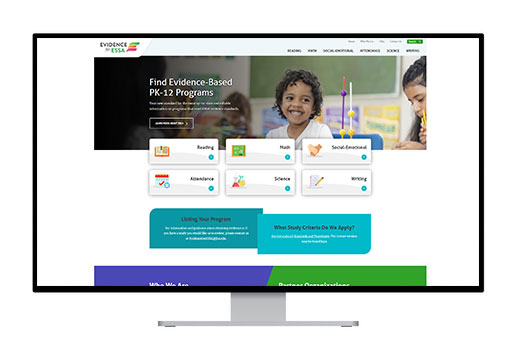Peer-Assisted Literary Strategies†or†PALS, is a technique in which children work in pairs, taking turns as teacher and learner, to learn a structured sequence of literacy skills, such as phonemic awareness, phonics, sound blending, passage reading, and story retelling. Children use a simple error-correction strategy with each other under guidance from the teacher.
Clearinghouse and Evidence Level
Evidence for ESSA
In December, 2015, Congress passed the Every Student Succeeds Act (ESSA), replacing No Child Left Behind (NCLB) as the main federal law governing K-12 education. Within the bill are provisions with potentially revolutionary implications for education because they promote the use of federal dollars on programs with evidence of effectiveness. More evidence on what works to increase student success is available now than ever before, and ESSA encourages the use of strategies with evidence of impact.
Level 2
Moderate evidence from at least one well-designed and well-implemented quasi-experimental study.
Quick Stats
Content Focus Area
Curriculum, Instruction, and Assessment
Grade Band
Elementary School
Number of studies
2
Intervention Information
The information below provides details and characteristics of the intervention. The presented information is sourced from another clearinghouse. To learn more about the intervention, click through to the Source clearinghouse.
This page displays information on the population and settings in which studies were conducted on the intervention’s effectiveness. This means that the intervention has some level of positive evidence in the listed student populations and context. Remember to take your school’s context and population into consideration when selecting an intervention. Read more on selecting interventions.
| Resource Type | Program Evaluation | This presents the grade level of students represented in the reviewed studies for this intervention. On the OEBC, grade bands are categorized into four levels: Early Childhood (Birth-Age 5), Elementary School (Grades K-5), Middle School (Grades 6-8), and High School (Grades 9-12). |
|---|---|---|
| Subject Area | English Language Arts | This refers to the school subjects: English Language Arts, Math, Science, and Social Studies. An intervention will be tagged with a subject if a reviewed study by the source clearinghouse has found that the intervention led to positive results in learning in that subject. |
| Setting | Not Listed | This presents the setting represented in the reviewed studies for this intervention. On the OEBC, setting has three categories: Rural, Urban, and Suburban. |
| Demographic |
| Demographic information refers to the student’s race/ethnicity and gender. It also includes information on subpopulations (e.g. Students with Disabilities, English Learners, Economically Disadvantaged, Justice Involved, and Foster Care). On the OEBC, an intervention is only tagged with demographic information if that intervention is specifically designed for, and has been reviewed on, that demographic. Please click through to the source clearinghouse to find total demographic breakdowns of all students who have taken part in a study on the intervention. |
| Training Needed | Not Listed | This indicates if the source clearinghouse has information on training needed to implement the intervention. | Length of Program or Delivery | Not Listed | This indicates if the source clearinghouse has information on how long the intervention takes to implement (e.g. session delivery time and/or how many days or weeks it takes to implement). |
| Cost | Not Listed | This indicates if the source clearinghouse has information on the cost to implement the intervention. |
| Effect Size | Listed | This indicates if the source clearinghouse provides an effect size for the intervention. Please visit the source clearinghouse to find the effect size and read more about the studies on this intervention. |
Studies Cited
- Mathes, P. & Babyak, A. (2001). The Effects of Peer-Assisted Literacy Strategies for First-Graders With and Without Additional Mini-Skills Lessons. Learning Disabilities Research & Practice, 16 (1), 28-44.
- Mathes, P., Torgensen, J., & Allor, J. (2001). The effects of peer-assisted literacy strategies for first-grade readers with and without additional computer-assisted instruction in phonological awareness. American Educational Research Journal, 38 (2), 371-410.

